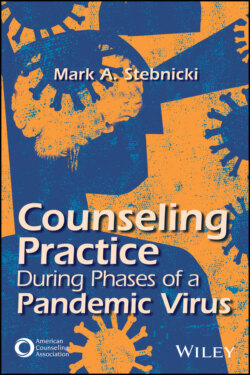Читать книгу Counseling Practice During Phases of a Pandemic Virus - Mark A. Stebnicki - Страница 16
Shortcomings in Theories of Pandemic Disaster Mental Health Response
ОглавлениеNatural disasters (e.g., floods, hurricanes, tornadoes, wildfires, earthquakes), person-made disasters (e.g., school shootings, terrorist attacks, workplace violence), and technological/biological disasters (e.g., cyberattacks, toxic chemical spills, nuclear and industrial accidents) have distinct psychological stressors and clinical characteristics. Similarly, pandemic disasters have unique characteristics of their own that hinder mental, behavioral, and psychosocial functioning. Each type of disaster has its own separate theories, constructs, and strategies that underlie the mental health response that are typically attributed and generalized to individuals, groups, communities, and world cultures (American Counseling Association, 2020; Baker & Cormier, 2015; Echterling et al., 2005; Lopez Levers, 2012; Stebnicki, 2000, 2005, 2007, 2008b, 2016a, 2017; Substance Abuse and Mental Health Services Administration, 2020c).
However, few studies address the mental, behavioral, and psychosocial health concerns of pandemic viruses such as the novel coronavirus (COVID-19). During the past 30 years, the extensive research on disaster mental and behavioral health has focused largely on natural and person-made disasters (Boss, 2006; Lopez Levers, 2012; Muratori & Haynes, 2020; National Organization for Victim Assistance, 2020; Schneider Corey & Corey, 2021; Stebnicki, 2016c, 2017; Van Der Kolk, 2014). For example, in the United States, studies of pandemic viruses have primarily centered on AIDS and HIV, which were first reported in 1981. There are four decades of research related to the HIV/AIDS epidemic and pandemic. Thus, there are a considerable amount of research related to the medical, physical, psychosocial, and behavioral aspects of these infectious diseases (Eaton & Kalichman, 2020). By 2006, the HIV/AIDS pandemic had resulted in an estimated 65 million infections and 25 million deaths worldwide (Centers for Disease Control and Prevention [CDC], 2006). The estimated number of positive cases of HIV/AIDS in 2018 had been reduced to approximately 38 million worldwide (UNAIDS, 2019). Thus, professional education, training, and HIV/AIDS prevention and intervention programs have demonstrated effectiveness in reducing the incidence and prevalence of this pandemic. However, the same is not true for the COVID-19 pandemic disaster, as health care providers and the public health infrastructure are overwhelmed. In addition, there has been a significant increase in the number of Americans experiencing depression, anxiety, substance use, and posttraumatic stress disorders.
Early researchers suggested that personal psychological growth is essential for transcending adversity and cultivating coping and resiliency skills during extraordinary stressful and traumatic events (Csikszentmihalyi & Nakamura, 2002; Siebert, 2005; Tedeschi & Calhoun, 2004; Updegraff & Taylor, 2000). The construct of resiliency encompasses other concepts, such as hardiness, resourcefulness, and mental toughness, which serve as coping resources for individuals in crisis (Schneider Corey & Corey, 2021). In the aftermath of a crisis, disaster, or trauma, it is vital that survivors draw on strengths and coping resources that perhaps were not recognized by themselves and others before the critical event (Stebnicki, 2017).
Over the past several years in the United States, there has been a resurgence of interest in studying the mental, behavioral, and psychosocial aspects of pandemic viruses. Emerging infectious diseases remain a top priority and challenge for public health officials engaged in the business of human survival (Germani et al., 2020; Morens et al., 2008; Pappas et al., 2009; Reyes et al., 2013; Wang et al., 2020). Today’s epidemiological and psychological concerns with viral infections may have arisen with the 2013–2016 outbreak of West African Ebola virus disease. A resurgence of the Ebola virus was observed in December 2013, when an 18-month-old boy from the rural forested region of southeastern Guinea was suspected of having been infected by bats. The Ebola pandemic was the largest, longest, deadliest, and most geographically expansive disease outbreak in the 40-year interval since Ebola was first identified in 1976 (Shultz et al., 2016). At the height of this disease outbreak in 2014, the Ebola virus spread globally. It coincided with the CDC training 6,500 U.S. health care workers and 24,655 other health care workers in West African countries of Guinea, Liberia, Sierra Leone, and Mali (CDC, 2019a). In 2014, the CDC reported 11 cases of travel-related Ebola virus in the United States. Fortunately, the spread and transmission of Ebola virus infection in the United States have not reached the levels of the COVID-19 virus.
The Ebola virus is one example of a virus with the potential to morph into a lethal viral contagion and become a pandemic. The pathways and transmission of Ebola and many other viruses, such as COVID-19, are of paramount concern for epidemiologists and world health care organizations tracing, tracking, and analyzing viral DNA to treat these highly infectious diseases and develop vaccines to prevent their spread. Unfortunately, the counseling, psychology, and disaster mental health fields have not kept pace with the virologists, epidemiologists, and other medical specialists who study viral contagions. Thus, it is essential that researchers gain a complete understanding of the mental, behavioral, and psychosocial risk and resiliency factors associated with pandemic viruses. A greater understanding is needed to treat individuals affected by the unique characteristics of a pandemic disaster.
